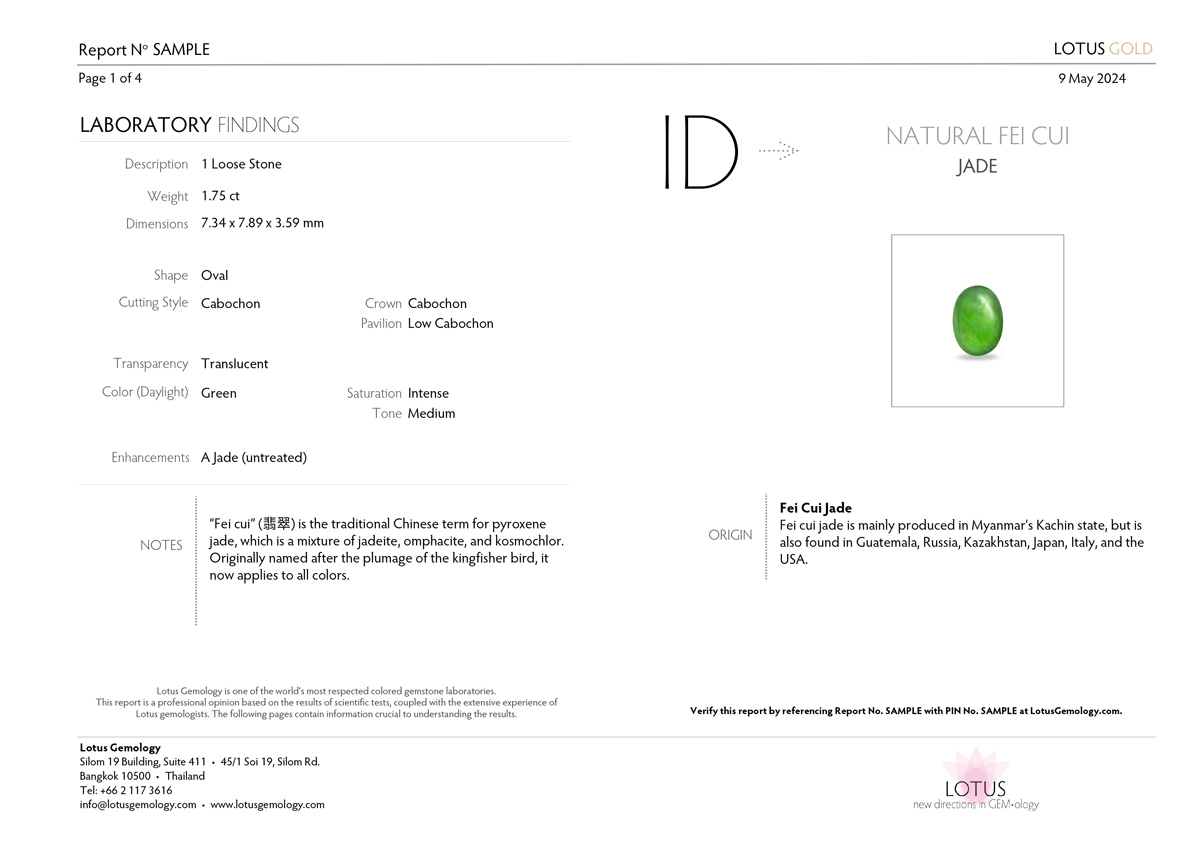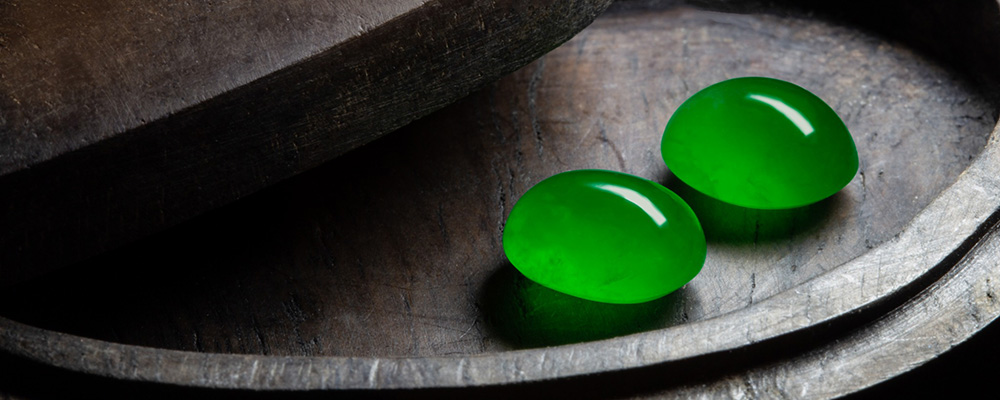Recent studies show that the gem known throughout the non-Chinese world as "jadeite" jade is actually a rock composed of three major mineral components – jadeite, omphacite and kosmochlor. These components grow in a submicroscopic aggregate with grains so small that normal lab instruments cannot easily determine the true composition. As a result, China's gem trade has adopted the traditional term "fei cui" (pronounced 'fay choy') to cover all the pyroxene jades. Lotus Gemology has done the same starting on 1 July 2023, dropping the names jadeite/omphacite/kosmochlor in favor of the scientifically more correct "fei cui."
Why has Lotus Gemology stopped using the term jadeite on its reports?
In the gemological world, since 1863 pyroxene jades have been largely labelled under the clinopyroxene species jadeite. Jadeite has now been depreciated because we understand that the gem previously termed "jadeite" (or 'omphacite') is not a single mineral species, but a rock mainly composed of three different pyroxenes – jadeite, omphacite and kosmochlor. Because there are no tests that can determine the relative percentages of each end member of an entire stone without destroying the specimen. Thus we have adopted the traditonal term for the gem that has been used in China for over a century, fei cui (翡翠). Fei cui is an umbrella term for pyroxene jade gems and has been legally approved in China (including Hong Kong) (GAHK, 2016).
Why have you chosen a Chinese word as a replacement for jadeite?
Fei cui is not a replacement, but the original word for this precious gem, a word that has existed for over a thousand years. The word "jadeite" is actually a newcomer, being coined by Alexis Damour in 1863 (Damour, 1863). Since it is not mineralogically accurate to use a mineral species name for a rock, and since the Chinese are not just the largest consumers of the material, but first named the gem, we believe it is appropriate to reinstate the Chinese name.
Doesn't fei cui mean green in Chinese?
It actually means red (fei – 翡) and green (cui – 翠), from the plumage of the kingfisher bird. As modern mineralogical analysis progressed, it became apparent that the base material of fei cui (a pyroxene rock) came in many different colors.
The eminent American gemologist, George F. Kunz, described it in 1888–89:
"Jadeite, or imperial jade or "feisui," as it is variously known, is generally white, with splashes or spots of a rich green, almost rivalling the emerald for vividness."
— George F. Kunz, 1888–89, The Art Amateur, Volume 20, Nos. 1–3, p. 3
Already by the year 1904, the definition had been extended, as the following statement from the noted orientalist, Stephen Wooton Bushnell shows:
"…fei ts'ui originally applied to the emerald green variety, is now extended to all other jadeites…"
— Stephen Bushnell, 1904, Chinese Art, Volume 1, p. 137
This is no different from sapphire, where the original definition (blue corundum) was extended to include all colors other than red (ruby).
Why are some labs able to specify when a specimen is jadeite or omphacite or kosmochlor?
The complexity of the interwoven nature of the various pyroxene species is not revealed by standard gemological testing. Instruments such as Raman and FTIR may produce spectra that resemble one of the three species, but studies done with back-scattered electron microprobe reveal that even areas that appear to be homogenous under light microscopy can still be intergrowths of tiny crystal grains of various species. Thus there is no easy way of determining composition using spectroscopy. Gemology needs to acknowledge that this gem is a rock, not a single mineral species, in the same way that lapis lazuli (a rock) is not lazurite (the dominant species in the rock). Geologists do not call fei cui jadeite, they call the rock jadeitite (or omphacitite or kosmochlorite, depending on which species they believe dominates).
If geologists call these rocks jadeitite (or omphacitite or kosmochlorite), why doesn't Lotus Gemology use those terms?
Because that requires thin-section petrographic analysis or other destructive techniques. In addition, we do not believe those terms are nearly as eloquent sounding as fei cui (kingfisher jade). And finally, we are a gem lab, not a geology lab. If we were a geology lab, we would use "red corundum" instead of "ruby."
Fei cui is difficult for non-Chinese to pronounce. Isn't there a more easily pronounceable word that could be used?
It's actually quite simple, it's pronounced "fay choy." Champagne is far more difficult to pronounce for native English speakers, but people have learned how to do it. For those who have trouble, they can simply call it "kingfisher" jade, which is the meaning in Chinese.
Can fei cui be used for treated stones?
Yes. Just like rubies don't stop being rubies when they are treated, fei cui doesn't stop being fei cui when it's treated. All treatments are clearly stated on our reports.
POSTSCRIPT
On 1 July 2023, Lotus Gemology dropped the name jadeite from our identification reports, replacing it with fei cui, as shown below. Future editions of Jade • A Gemologist's Guide will do the same.
 Sample Lotus Gemology report for fei cui jade, showing the wording that appears on the report. Click on the image for a PDF of the full report.
Sample Lotus Gemology report for fei cui jade, showing the wording that appears on the report. Click on the image for a PDF of the full report.

References & Further Reading
- Bushnell, S.W. (1904) Chapter VII. Carving in jade and other hard stones. In Chinese Art, London: Victoria and Albert Museum, 2 Vols., jade, see Vol. 1, pp. 134–151.
- Damour, A. (1863) Notice et analyse sur le jade vert: Réunion de cette matière minérale à la famille des wernerites. [trans. into English by Herbert Giess in the Bulletin of the Friends of Jade, 1994, Vol. 8, pp. 51–54], Comptes Rendus Hebdomadaires des Séances de l'Académie des Sciences, Vol. 56, 4 May, pp. 861–865.
- Gemmological Association of Hong Kong, ed. (2016) Standard Methods for Testing Fei Cui for Hong Kong. Hong Kong: Gemmological Association of Hong Kong, unpaginated (~46 pp.).
- Hughes, R.W., ed. (2022) Jade: A Gemologist's Guide. Lotus Publishing: Bangkok, 534 pp.
-
Khourie, K. (2023) The hardness of fei cui • A gemmological perspective. Journal of the Gemmological Association of Hong Kong, Vol. 44, pp. 45–57.
-
Kunz, G.F. (1888–89) The Cabinet • Talks with Experts • VI. Mr. George F. Kunz on art works in jade and other hard stones. The Art Amateur, Vol. 20, Nos. 1, 3, pp. 3–4, 51–52.

